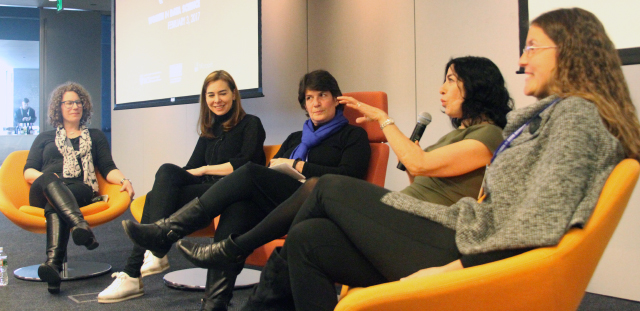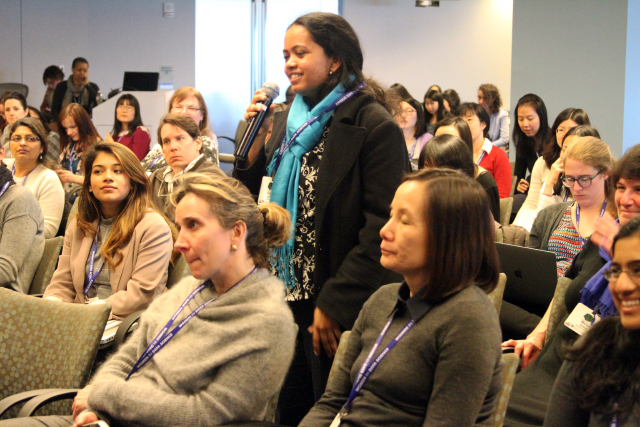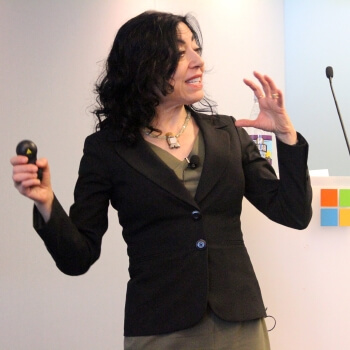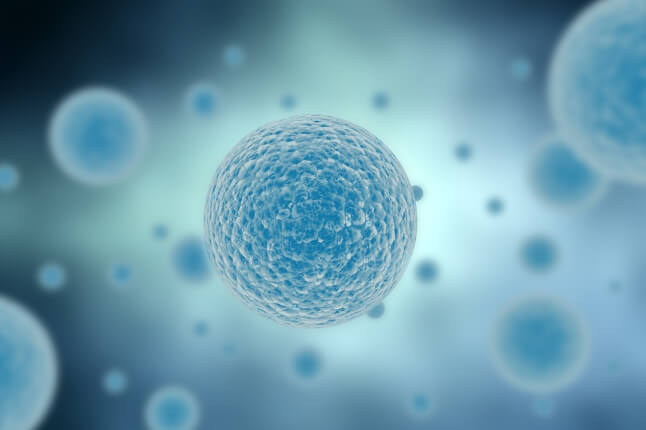News
Jennifer Chayes, managing director and co-founder of Microsoft Research New England, opened the Women in Data Science conference by discussing challenges involved in network science. (Photo by Adam Zewe/SEAS Communications.)
“Be the smart girl. . .The best way to fight implicit bias is through hard work.”
That was the advice Margo Seltzer, Hershel Smith Professor of Computer Science, offered to more than 100 female technologists, researchers, and students who gathered in Cambridge, Mass., for the global Women in Data Science Conference (WiDS), a daylong event to inspire, connect, and educate women in tech.
Held on Feb. 3 at Microsoft’s New England Research Center, the conference was hosted by the Institute of Applied Computational Science (IACS) at the Harvard John A. Paulson School of Engineering and Applied Sciences; the MIT Institute for Data Systems, and Society; and Microsoft. It was one of more than 75 WiDS events held simultaneously around the world.
Local speakers discussed a range of data science topics, including the role of machine learning in genetics, algorithmic models for weather forecasting, and the use of wireless networks to infer health information.

WiDS panelists (from left) Jennifer Listgarten, Dina Katabi, Margo Seltzer, Jennifer Chayes, and Caroline Uhler discuss the future of the data science field. (Photo by Adam Zewe/SEAS Communications.)
Jennifer Chayes, managing director and co-founder of Microsoft Research New England, opened the symposium by discussing challenges involved in network science. Conducting a simple web search, for instance, relies on a complicated cloud data network that is processed through large-scale data centers, she explained.
“Today, those data centers are using about 5 percent of the total energy in the U.S. and it is doubling every two to three years,” she said. “We need to come up with much better algorithms for doing this in better networks that are fueled by renewable energy sources.”
The necessity to analyze a rapidly growing amount of data has forced tech companies like Google to continually innovate, said Diane Greene, senior vice president of Google’s cloud businesses, during a live-streamed presentation from Stanford University.
The company is using machine learning and big data to help customers in ways that were unimaginable even a few years ago, from increasing farmers’ cucumber yields to enabling easier diagnosis of diabetic retinopathy.
“One of the coolest things about machine learning is that, the more you learn, the smarter you get, and it never goes away,” she said.
But integrating machine learning into an end-user product is challenging for many smaller tech firms, often due to the tension that exists between researchers and engineers, said Angela Bassa, director of data science at iRobot.
Utilizing diverse teams, achieving consensus, and being able to explain algorithmic models to people who lack data science backgrounds can guide a commercial project to success.
“To get a better solution at the end you want to enable innovation that allows engineers to build something, but in a way that fosters the curiosity and the academic pursuit that will be part of your insight engine,” she said.

More than 100 female technologists, researchers, and students gathered in Cambridge for the Women in Data Science Conference, one of more than 75 events held around the world on Feb. 3. (Photo by Adam Zewe/SEAS Communications.)
According to the American Association of University Women, only 26 percent of computing professionals and 12 percent of engineers are women. The conference concluded with a panel discussion, moderated by Seltzer, during which speakers offered career advice and encouragement for female peers working in gender-imbalanced tech fields.
Panelists shared personal stories and spoke about the importance of having strong mentors and coaches, as well as the need to remain determined in the face of both implicit and explicit bias.
“We as women should believe that it is great to do math and be leaders and be strong,” said Dina Katabi, Andrew and Ema Viterbi Professor of Electrical Engineering and Computer Science at MIT. “We all have to create a better environment for the next generation by saying ‘no’ and pushing the boundary.”
Topics: Computer Science
Cutting-edge science delivered direct to your inbox.
Join the Harvard SEAS mailing list.
Press Contact
Adam Zewe | 617-496-5878 | azewe@seas.harvard.edu



